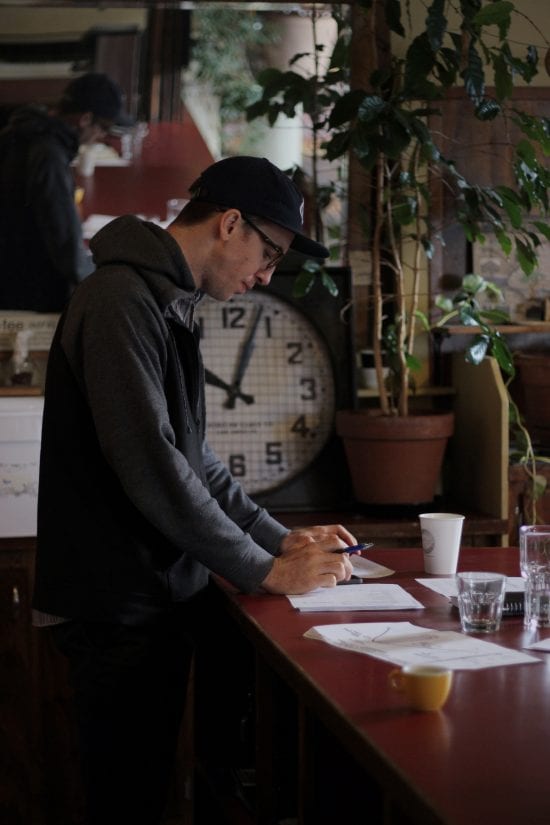
Can beer brewers become roasters? Are coffee and beer at all the same? In this series, Ben Dorrington gives us an intimate look at his transition from the beer world to the coffee world.
BY BEN DORRINGTON
SPECIAL TO BARISTA MAGAZINE
Episode Two: On cupping, peach tea, and my first natural coffee
(If you’re new to this series, you can check out episode one here.)
I’d allowed myself a three-day weekend—a reward, I told myself, for making it through those last two weeks of brewery work. We slept in, made some excellent Colombian coffee, went swimming with our six-month-old, and just generally took it easy. I suppose all the while the knowledge of the coming challenge was in my head, just banging around somewhere in the back. About 8 p.m. on Sunday, however, I was suddenly very aware. The butterflies and nerves made a quick appearance, only to be beaten back by some seriously positive self-talk. I was ready, it was time, let’s coffee. (Can one ‘coffee?’)
Monday, for Discovery Coffee, begins with a roastery meeting and a cupping. Despite being a big fan of specialty coffee for a long time, I have to admit I’ve often taken the concept of cupping and tasting notes with a grain of salt. One, the name ‘cupping’ is a teenager’s dream in terms of joke material. Two, are coffees truly that different? I was always under the impression that it was only with extensive coffee-tasting experience that one would be able to pick out individual flavor and aroma compounds. I couldn’t have been more wrong. With a brief introduction and explanation of why cupping is what it is (fantastic that the procedure/ritual can be performed with little more than cups, spoons, ground coffee and hot water!), we are off on the journey. Brittany Davies, our Education Manager, has set us up with a mix of our current coffees, test roasts, and a couple of single origins from other roasters.
We grind, sniff, pour, sniff, break, sniff, skim, sniff, and then begin to taste.

Immediately, as we sample the aromas, I begin to notice differences. Some smell delicately like peach, others like cinnamon and baking spice … and some don’t smell good. As the tasting begins, my mind is solidly blown. The first cup tastes like coffee—delicious, delicate coffee. The second cup, whoa, tastes slightly like tea, black, maybe a little bergamot, like an Earl Grey vibe. The third cup is the one that really begins to rupture my neurons. Peach tea! Yes, it tastes boldly and most definitely like peach tea. Snapple, but not as sweet. It then gently fades to a smooth finish. This simple side-by-side comparison surprises a lifelong specialty coffee drinker!
The rest of the table is a mix of bold and delicate flavors, some floral, some spice, and some fruit. We also all manage to pick out a coffee roasted six months ago (it’s flat and one-dimensional, with no real discernible flavor notes).

However, it is the last cup on the table that throws everything I think I’ve learned out the window. The aroma is big, fruity, and strong, like a really good-quality fruit tisane. The initial taste is incredible, berry fruit, and sticky date … and it just … keeps … going! As the coffee floods over various taste buds, flavor receptors, and down my throat, the flavors surge, change, and melt together. I quickly discover this is a naturally processed Ethiopian coffee from Pallet Coffee Roasters in Vancouver. I never knew coffee could ever taste like this!

We end the session with a pourover version of a new blend the roastery team has been working on. With a realization that my skills honed through tasting beer will also serve me well in tasting coffee, I am able to confidently contribute to describing our new offering. Cinnamon and baking spice aromas, bittersweet chocolate, and ‘hokey pokey’ flavors. Hokey pokey, for those of you unfamiliar with New Zealand culture, is one of our staunchly defended traditional ice cream flavors. Think Crunchie bar sponge toffee and vanilla ice cream. We decide to modify it slightly and simply call it ‘toffee’ (going for approachability here).

The rest of the day consists of passionate discussion about coffee history, the coffee waves, ethics in coffee buying, and introductions to a dozen or so staff and regulars. As with my previous coffee industry interactions, it all feels easy, friendly, and flowing. Immediately I am feeling very fortunate to be a part of this business and the community. I’ll say it again: Coffee people, as it turns out, are most definitely my people!
Sidenote: How have I never discovered cortados before this week?
 ABOUT THE AUTHOR
ABOUT THE AUTHOR
Ben Dorrington is a beer and coffee enthusiast. He has been a beer brewer for years, and is just getting his feet wet with coffee. He lives in Victoria, British Columbia, with his wife and daughter.


Ben where can I get the CK hat?